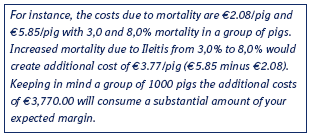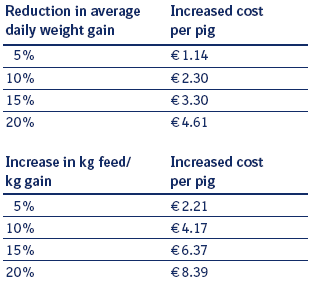2.4.2 Daily weight gain, feed conversion rate and number of days to market
One of the fundamental biological functions in pork production is growth. If efficient growth is inhibited, the amount of feed needed to produce 1kg gain is unavoidably affected as well.

The actual feed conversion rate depends on a number of farm specific factors such as feeding system, environmental conditions and overall disease situation. Enteric diseases will prevent the physiological digestion of the feed which can lead to an over-proportional increase in the feed conversion rate. Table 2.4 b shows the economic effect of a reduction in daily weight gain and the loss in feed conversion.

Table 2.4 b
The costs of poor growth and reduced feed conversion.
*Assumptions: 25 kg to 115 kg pig growth; feed price ¤170/t; ADWG 750 g; Feed conversion rate 2.91.
The greater the reduction in daily weight gain and the higher the feed conversion loss are, the higher is the economic loss per pig. It can be seen from Table 2.4 b that reduction in average daily weight gain of 10% creates about ¤2.30/pig additional costs compared to ¤4.17/pig as a result of a 10% lower feed conversion.
It is apparent that Ileitis has an impact on the costs of pork production but it is often underestimated that Ileitis has an impact on the value of the slaughtered animals as well.
© Boehringer Ingelheim Animal Health GmbH, 2006
All rights reserved. No part of this Technical Manual 3.0 may be reproduced or transmitted in any form or by any means, electronic or photocopy, without permission in writing from Boehringer Ingelheim Animal Health GmbH.






